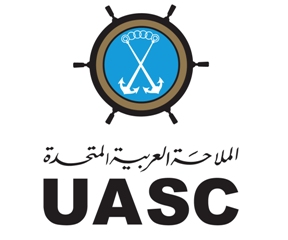 United Arab Shipping Company’s recent confirmation that it has ordered five 18,000-TEU vessels and five 14,000-TEU vessels for delivery between late 2014 and mid-2015 will increase UASC’s vessel capacity by around 60 percent, and propel it from the bottom of the top 20 league to the lower ranks of the top 12.
United Arab Shipping Company’s recent confirmation that it has ordered five 18,000-TEU vessels and five 14,000-TEU vessels for delivery between late 2014 and mid-2015 will increase UASC’s vessel capacity by around 60 percent, and propel it from the bottom of the top 20 league to the lower ranks of the top 12.
It is the first major challenge to the top players’ vessel capacity supremacy since Cosco Container Lines and China Shipping Container Lines (CSCL) burst into the container market in the late 1990s, said Drewry Maritime Research.
The vessel order by UASC indicates its plans to expand its presence between Asia and Europe, “although how it will be achieved remains unclear,” continued Drewry.
Still, the consulting firm forecasts that UASC will seek to join forces with other like-minded ocean carriers on the Asia-Europe trade lane in order to establish enough service frequency to take on the remaining big players.
One possibility is that the five 18,000-TEU vessels from UASC could combine with CSCL’s five 18,400-TEU vessels into another major weekly string between Asia and Northern Europe.
At present, UASC provides only three 13,300-TEU vessels in the AEC8’s weekly service between Asia and Northern Europe, which is shared with six 14,100-TEU ships provided by CSCL and one 12,600-TEU vessel from CMA CGM.
Before the order confirmation, the top 12 appeared to solidify their supremacy in the industry, with about 61 percent of all vessel capacity already under their control towards the end of 2012.
Moreover, they control about 55 percent of all cellular capacity delivered or to be delivered this year, and at least 59 percent of all ordered cellular vessel capacity due for delivery in 2014.
The top 12 also clearly plan further vessel upgrades from between 10,000 TEU and 13,000 TEU to between 14,000 TEU and 18,000 TEU due to the economies of scale offered by the bigger vessels.
Thus, they “will not be sweating too much over UASC’s order,” said Drewry. Apart from the fact that it will add unwanted capacity to the global fleet, the Middle East-based state-owned carrier controlled only 1.5 percent of all vessel container capacity in October last year, and will still control less than 2 percent at the end of 2014, when the first vessels are due for delivery.
However, it does mean that the market is set to become more influenced by state-controlled liner companies, such as Cosco, CSCL, and APL, said Drewry.
As of October last year, the top 12 global ocean carriers are, from first place to 12th: Maersk Line, Mediterranean Shipping Co., CMA CGM, Cosco, Evergreen Shipping, Hapag-Lloyd, APL, CSCL, Hanjin Shipping, Mitsui O.S.K. Lines, Orient Overseas Container Line, and Hamburg Sud.




